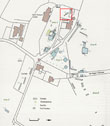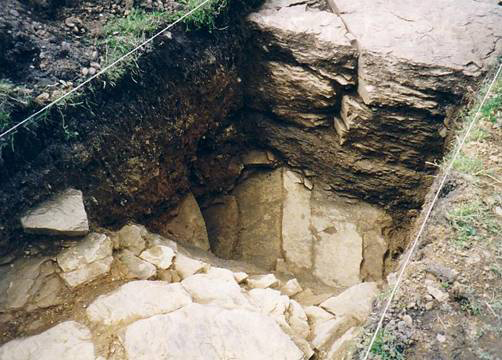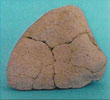
Highlights of the 1998 Excavations


First of all resistivity surveys were carried out over the field where the crop marks had been noticed and which seemed to indicate the possibility of a ditch or similar feature, confirming the continuation of the line. they went on to find other features in Old Vicarage garden. Excavation followed in the summer of 1998, as a training exercise with students from the University of Manchester Archaeological Unit under the direction of Graham Eyre-Morgan. The students found post-holes in Trench TX1, unexplained activity in TX2, and moved to TX3 near the vegetable garden.


 The students started to open up what was later named Trench 1 and after a few days reached Bedrock. It was a wet day, they found nothing and went home early. Graham arrived later, started trowelling in the same area and found the edge of a cut in the bedrock.
The students started to open up what was later named Trench 1 and after a few days reached Bedrock. It was a wet day, they found nothing and went home early. Graham arrived later, started trowelling in the same area and found the edge of a cut in the bedrock.By the time Ann and John arrived home after a soggy "Antiques Roadshow" at Lyme Park, he was jumping up and down with excitement shouting " This is serious archaeology! "




Over the next weeks, as excavation continued, a deep defensive ditch was uncovered. Amazingly Roman Pottery and roof tiles were found within the upper part of the fill and below that VCP (Very Coarse Pottery )and Fire Cracked Pebbles from the Iron Age. A tree prevented full excavation but a diagonally opposite quadrant exposed the other side of the ditch, which revealed that the feature measured fully 4 metres wide.
They concluded that what had been found unedr the flat suburban lawn was the remains of an Iron Age Hilltop Settlement built on the site of earlier prehistoric activity and that it had either been continuously occupied or was re-used during the 1st or early 2nd Century Roman Occupation of Britain. Such a discovery radically altered our understanding of both the history and pre-history of the area and led Ann and John to decide to set up the Mellor Archaeological Trust in order to continue the investigation.
Read the full 1998 Archaeological Report from the University of Manchester Archaeological Unit
